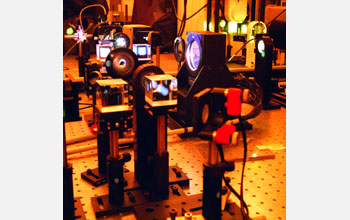Multimedia Gallery
Sunlight in the Dark
Sunlight in the Dark
The mirror at center right doesn't look like an ironing board, but that's its basic role in a new high-order adaptive optics system that cancels most of the atmosphere's blurring.
An irony of modern solar observing is "photon starvation." Observing small areas at high resolution, and in narrow spectral bands, reduces the amount of light arriving at the detector. This requires turning down interior lights that would introduce noise into the data. Shown here is the high-order adaptive optics (AO) setup at the Dunn Solar Telescope of the National Science Foundation's (NSF) National Solar Observatory at Sunspot, N.M. The mirror at right in this picture deforms to compensate for blurring caused by Earth's atmosphere. Other components include beamsplitters that direct light to different parts of the AO system and to the instruments. Success with this project has paved the way for NSO to design and propose the NSF-funded 4-meter Advanced Technology Solar Telescope, the world's largest optical solar telescope. (Date of Image: unknown)
Credit: Dave Dooling, NSO/AURA/NSF
Special Restrictions: The materials created, authored and/or prepared by the National Solar Observatory (NSO) are copyrighted in content, presentation and intellectual or creative origin. Before using this image, you must first read the Conditions of Use for NSO Images. Use of NSO/AURA images constitutes acceptance of these guidelines.
Images and other media in the National Science Foundation Multimedia Gallery are available for use in print and electronic material by NSF employees, members of the media, university staff, teachers and the general public. All media in the gallery are intended for personal, educational and nonprofit/non-commercial use only.
Images credited to the National Science Foundation, a federal agency, are in the public domain. The images were created by employees of the United States Government as part of their official duties or prepared by contractors as "works for hire" for NSF. You may freely use NSF-credited images and, at your discretion, credit NSF with a "Courtesy: National Science Foundation" notation.
Additional information about general usage can be found in Conditions.
Also Available:
Download the high-resolution JPG version of the image. (4.3 MB)
Use your mouse to right-click (Mac users may need to Ctrl-click) the link above and choose the option that will save the file or target to your computer.

